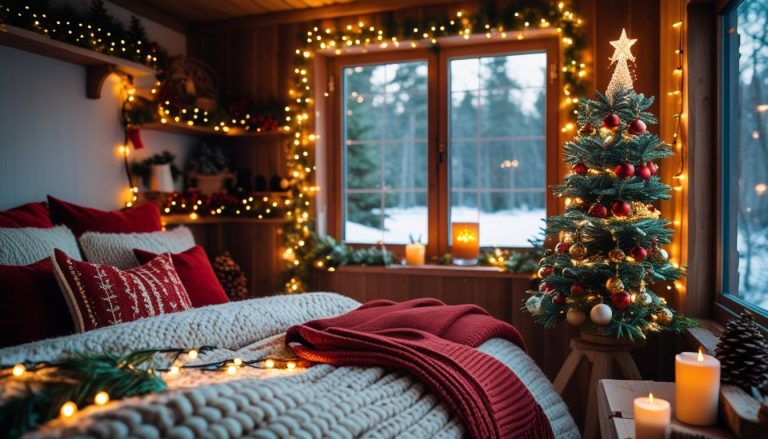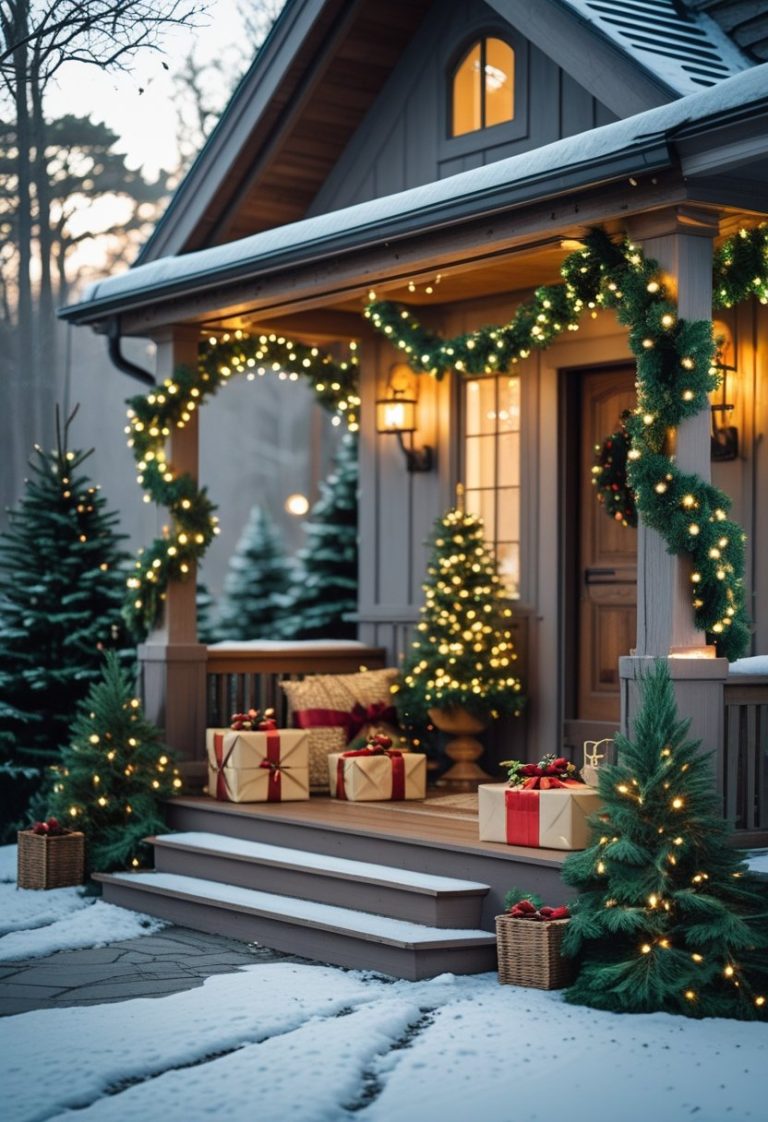Cozy Christmas Staircase Garland Ideas 2025
This image of Christmas Staircase Garland captures Christmas staircases adorned with lush garlands, twinkling string lights, red plaid ribbons, hanging stockings, and festive ornaments. These elements combine to create a cozy, traditional holiday atmosphere while adding a modern touch.

Decorating a staircase with garlands, lights, ribbons, and ornaments is an effective way to bring warmth and festive spirit to any home during the holiday season. The mix of classic and contemporary styles serves as practical inspiration for those looking to elevate their holiday decor with simple yet impactful touches.
By focusing on textures and colors that blend tradition with current trends, the staircase becomes a welcoming focal point that ties together festive decorations throughout the home. This approach encourages creativity while maintaining a timeless holiday feel.
Key Elements of Beautifully Decorated Christmas Staircases
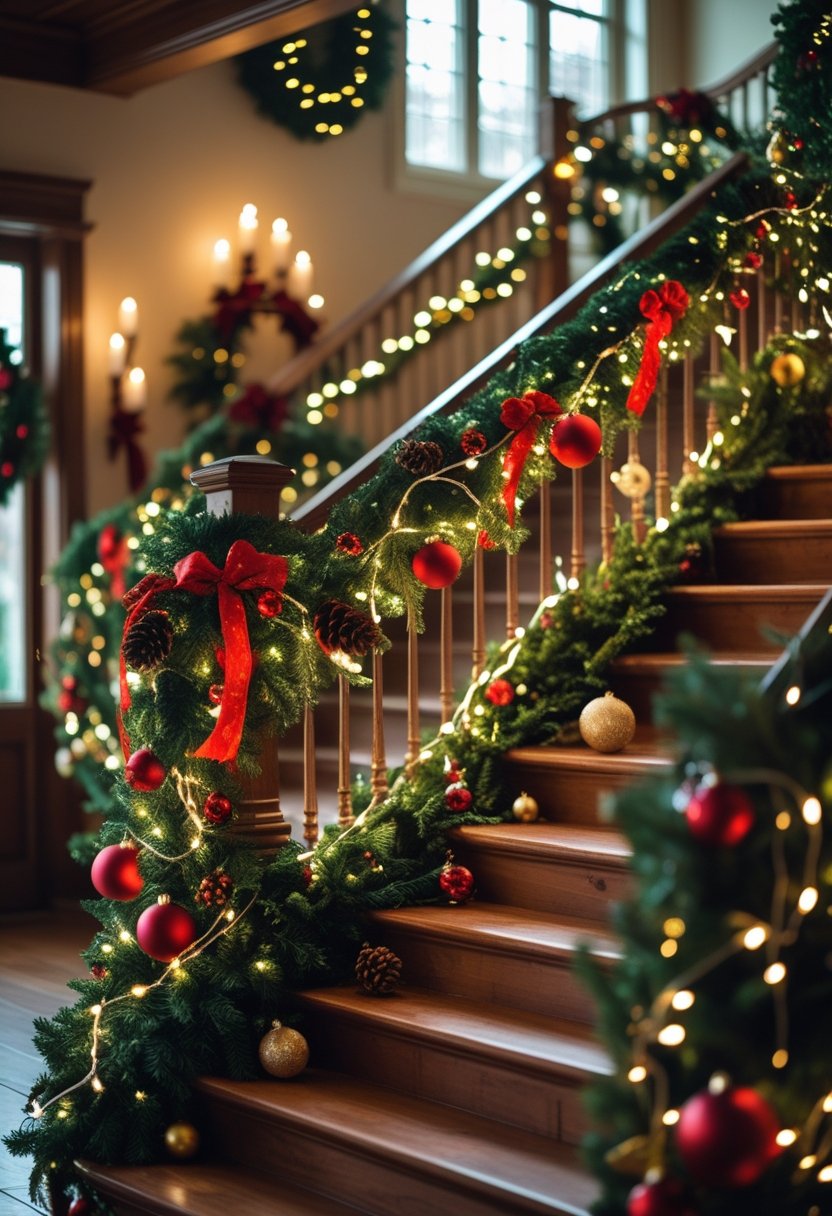
Beautifully decorated Christmas staircases combine greenery, lighting, ribbons, and festive accents to create a warm and inviting holiday display. Each component plays a distinct role in elevating the staircase as a holiday focal point, balancing tradition and seasonal charm.
Lush Greenery and Garland Types
Staircase garlands are foundational to Christmas staircase decor. Pine garlands remain the most popular choice, providing a rich, natural texture and a classic holiday scent. Alternatives include fir, cedar, or mixed greenery garlands, which add variety and depth.
Artificial garlands offer durability and ease of use, often pre-lit or embellished with pine cones and berries. Natural garlands require gentle maintenance but bring authenticity and fresh fragrance. Draping these along banisters or wrapping them around newel posts sets the stage for further decorations.
The fullness and density of the garland impact visual balance. Thicker lush garlands create a bold statement, while slimmer designs offer elegance suited for modern or minimalist styles. Either way, garlands remain essential for layering other decor elements.
Twinkling Lights and Illumination Techniques
Twinkling lights enhance the festive mood and emphasize garland details. Strings of warm white fairy lights are most common, adding a soft glow without overpowering other elements. LED string lights save energy and provide consistent brightness.
The placement of lights matters: weave them evenly throughout the garland or wrap spirally around the banister. Concealing wires behind greenery ensures a clean look. Some opt for battery-powered lights to avoid visible cords and maintain flexibility in placement.
Lights can be combined with other illumination, such as pillar candles or lanterns near the staircase base, to create layers of light. Controlled lighting enhances textured surfaces like pine needles and ornaments, creating visual interest while maintaining a cozy atmosphere.
Statement Ribbons and Bow Accents
Ribbons add color, texture, and style to staircase Christmas garlands. Red plaid ribbons are timeless, lending a traditional, warm holiday feel. Velvet or burlap ribbons suit rustic designs, while satin or metallic ribbons cater to elegant, modern decor.
Large bows placed at regular intervals on the garland break up greenery and serve as focal accents. The size of bows should be proportionate to the staircase width and garland thickness, avoiding overcrowding.
Ribbons can cascade down the banister or be woven into the garland, introducing movement and softness. Coordinating ribbon color with ornaments or stockings ties the design together cohesively.
Hanging Stockings and Festive Touches
Hanging stockings along the staircase banister adds a nostalgic and personal touch to holiday decor. Stockings can be uniform or varied in color and pattern to reflect family style. Hooks with secure attachment prevent slipping or damage to garlands.
Additional festive touches include ornaments, pine cones, artificial berries, and small decorative figurines like snowmen or reindeer. These can be attached using ornament hooks or wired gently into garlands, providing depth without overwhelming the space.
Maintaining balance is key; decorations should complement rather than clutter. The combination of stockings and smaller festive accents personalizes the staircase and invites guests into the holiday spirit.
Ornaments and Decorative Accessories for Staircase Styling

A well-decorated staircase combines varied ornament types, thoughtful placement, and coordinated color accents. Using festive elements like red berries, gold ornaments, and striking focal pieces can elevate the overall holiday atmosphere. Attention to detail in ornament choice and arrangement creates a polished and inviting look.
Choosing and Placing Christmas Ornaments
Selecting the right ornaments begins with considering size, shape, and color harmony. Small to medium-sized ornaments work well draped along garlands, providing depth without overwhelming the space. Clusters of red and gold ornaments add classic touches that complement greenery.
Placement is crucial. Evenly spacing ornaments ensures a balanced effect, while occasional groupings of multiple pieces create visual interest. Hung ornaments should be secure and positioned at varying heights to avoid uniformity. Adding textured items, like red berries or matte finishes, brings contrast to glossy ornaments.
Incorporating Red and Gold Accents
Red and gold remain timeless color choices for Christmas staircases. Red ornaments and ribbons provide warmth and festive cheer that instantly draw the eye.
Gold ornaments, whether matte or metallic, introduce elegance and reflect light softly. Combining these accents keeps the decor rich but refined. Red berries woven into garlands add an organic feel, enhancing the traditional look.
Using red plaid ribbons alongside gold bows enhances the color palette with texture. These accents also help tie larger decorative elements together for cohesive styling.
Oversized Ornaments and Focal Point Ideas
Oversized ornaments serve as statement pieces that anchor the staircase decor. Large baubles or decorative stars placed sporadically on garlands deliver immediate visual impact.
A well-chosen focal point might include a cluster of oversized red and gold ornaments at the staircase base or a standout wreath above the bannister. This draws attention and introduces layered dimension.
Pairing these with smaller ornaments around them prevents the display from feeling top-heavy. Balanced focal points create a structured, intentional design rather than a haphazard arrangement.
Ribbon Trends: From Classic Red to Modern Styles
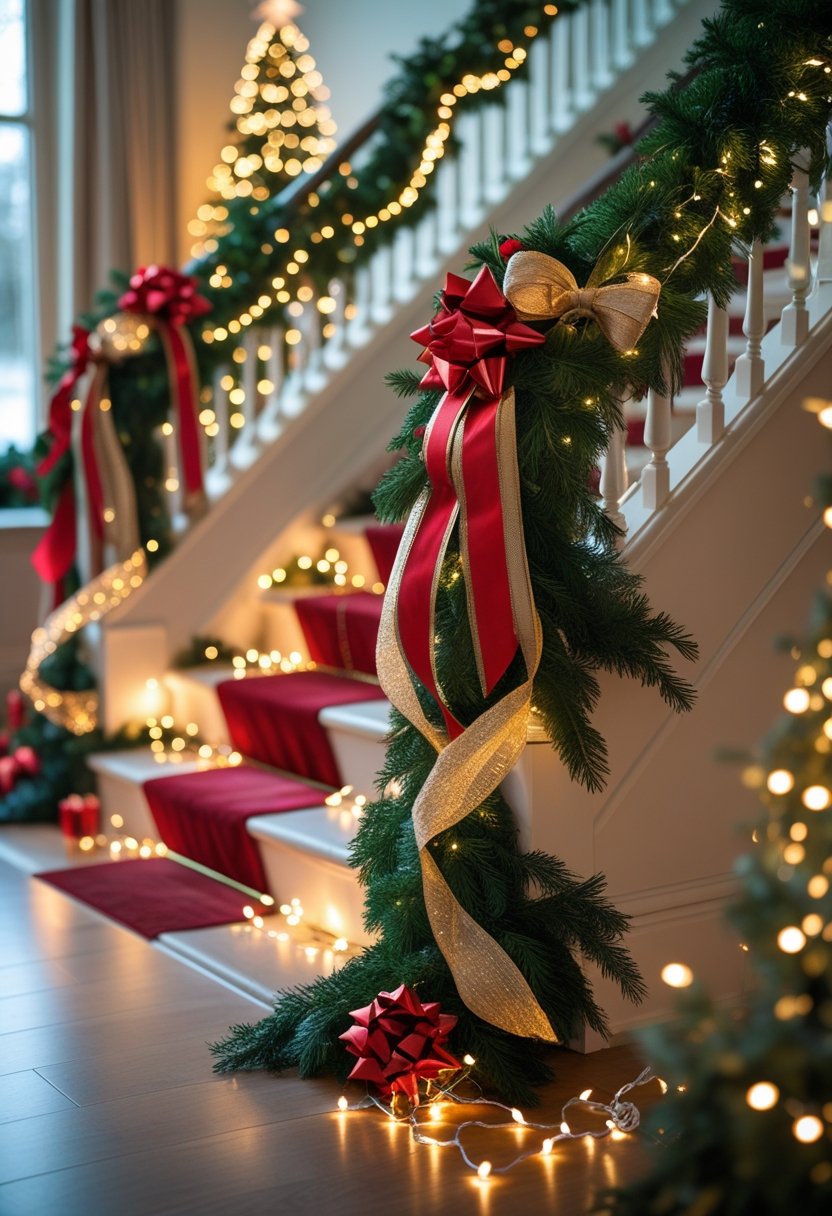
Ribbon choices this season range from timeless reds to bold, contemporary hues. Materials vary from soft velvets to shimmering metallics, offering a broad palette for holiday decorating. Different ribbon textures and colors create distinct moods, whether traditional or modern.
Classic Red Ribbon Finishes
Red ribbons remain a staple in Christmas decor. They convey warmth and tradition, anchoring seasonal designs with familiarity. The most popular variants include bright satin and rich red velvet ribbon, both bringing deep color and texture.
Red velvet ribbons add plush softness, perfect for wrapping stair garlands or bows. Satin red ribbons reflect light, enhancing sparkle alongside twinkling lights and ornaments. Red ribbons often feature simple edges or subtle patterns like plaid, helping maintain a classic but refined look.
Velvet and Metallic Ribbon Options
Velvet ribbons extend beyond red, offering a luxurious touch in deep greens, burgundies, and navy. Their matte finish contrasts well with glossy ornaments and shiny garlands. Velvet’s thickness also allows for fuller bows that hold shape on staircases or mantelpieces.
Metallic ribbons combine elegance and brightness. Gold and silver metallic ribbons, often wired for structure, add shimmer and heighten festive glam. These ribbons work well intertwined with garlands, emphasizing light reflection and creating visual layers without overwhelming the overall decor.
Embracing Blue and Contemporary Ribbon Shades
Blue ribbons represent a shift toward modern holiday palettes. Shades of navy, royal blue, and icy blue bring a cool, sophisticated tone suited for minimalist or Scandinavian-inspired décors.
Blue ribbons, whether satin or velvet, contrast nicely with traditional greens and whites. They add diversity without clashing. Using blue ribbons alongside silver metallics or white lights enhances elegance, creating a stylish new take on seasonal decorating.
Integrating Natural Elements for a Cozy and Traditional Vibe

Using natural elements adds warmth and texture to Christmas staircases, enhancing their traditional charm. Thoughtful combinations of greenery, dried fruits, and floral accents can create a rustic yet refined holiday look.
Pinecones, Pine Branches, and Greenery Mixes
Pinecones and pine branches form the foundation of natural Christmas decor. Their rich green needles and earthy textures bring a fresh, forest-inspired feel to staircases. Mixing different types of greenery, such as fir, spruce, or cedar, adds depth and variety.
Pinecones offer a natural focal point that complements string lights and ribbons. They can be attached directly to garlands or clustered for added dimension. A simple spray of white paint or glitter can provide subtle contrast without overwhelming the organic look.
Using lush greenery with sturdy pine branches ensures the garland maintains shape and fullness over time. This creates a lasting and visually appealing display that blends classic elements with a modern sensibility.
Rustic Accents: Dried Orange Slices and Poinsettias
Dried orange slices introduce warm, citrusy tones and a vintage touch to staircase decor. Their translucent texture catches light, creating natural highlights within the garland. They pair well with pinecones and greenery when spaced evenly along the railing.
Poinsettias add bold seasonal color with their deep red leaves and crisp structure. Incorporating real or high-quality artificial poinsettias enhances the festive mood without detracting from the natural aesthetic.
Together, these rustic accents balance natural greens and browns with vibrant reds and warm orange hues. They enrich the overall composition, making the staircase feel inviting and carefully curated for the holiday season.
Creating Inviting Ambiance With Lighting and Layered Textures
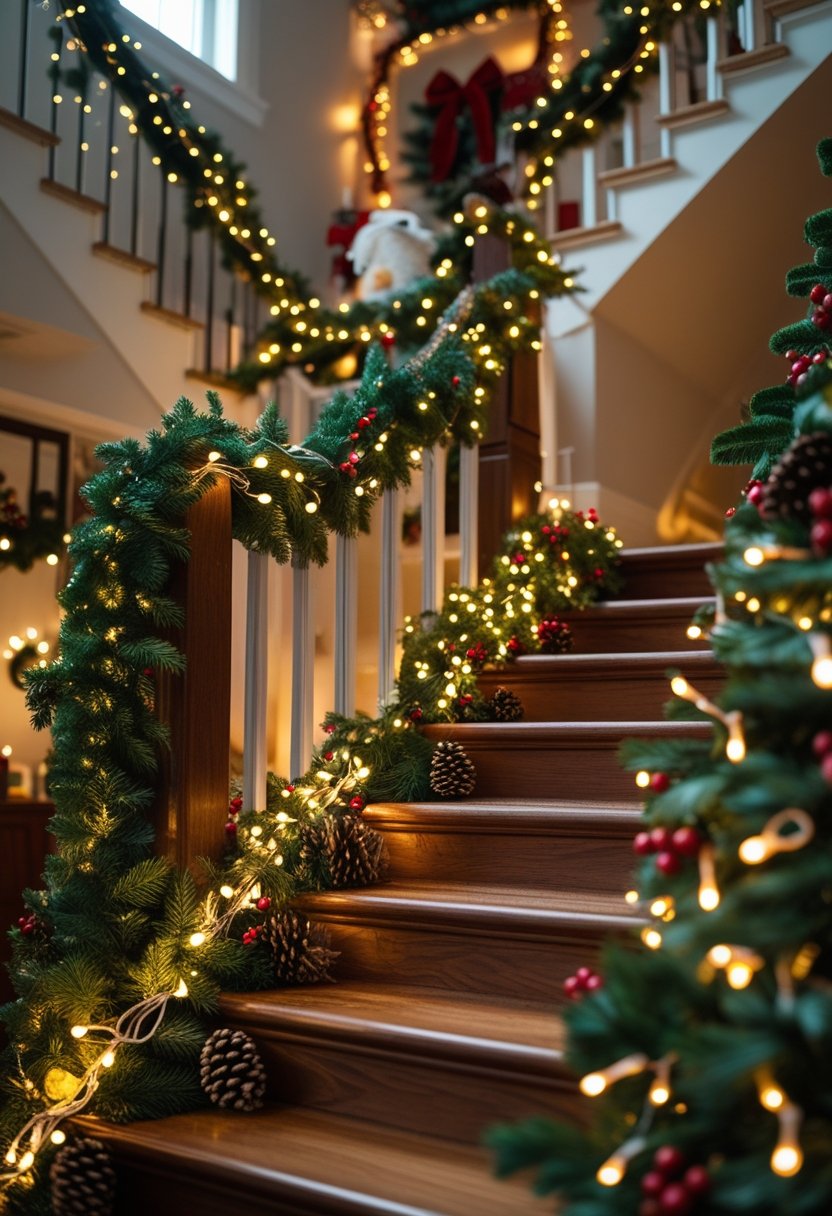
Lighting and textures work together to heighten the festive feel of a Christmas staircase. Thoughtful placement of fairy lights enhances the glow, while layered garlands add visual complexity. Combining frosted elements with plush materials elevates traditional decor into a refined holiday scene.
Fairy Lights and String Lighting Placement
Fairy lights or small string lights wrapped around the stair railing offer a soft, warm glow that defines the space’s mood. Placing lights evenly along the length of the garland ensures a consistent twinkle without overwhelming brightness.
For a modern touch, cluster some lights near the bottom or corners to create focal points. Using warm white bulbs is effective as they produce a cozy ambiance while highlighting ornaments and ribbons. Battery-powered lights add flexibility for placement without visible wires.
Layering Garlands for Visual Depth
Layered garlands on stairs create depth and texture by combining different foliage types and sizes. A mix of lush green branches with accents of frosted garland helps achieve contrast and interest.
Start with a full base garland, then weave in smaller sprigs, pinecones, or ribbons for dimension. Red plaid ribbons or ornaments placed strategically break the greenery monotony and complement the lighting. Securing layers firmly avoids slumping while maintaining a natural flow.
Frosted and Luxurious Staircase Ideas
Frosted garlands introduce a wintery effect, simulating snow and adding brightness without extra lighting. They work well alongside warm fairy lights, which balance the cool tones and keep the space inviting rather than stark.
Luxurious Christmas staircases often feature soft velvet ribbons, gold or silver accents, and plush stockings. Combining these rich textures with twinkling string lights elevates the traditional style into an elegant atmosphere.
Using metallic elements or satin finishes alongside frosted greenery offers a refined contrast that catches light subtly. This layering of textures emphasizes both warmth and sophistication in holiday decor.
Practical Tips and Safety for Decorating Christmas Staircases
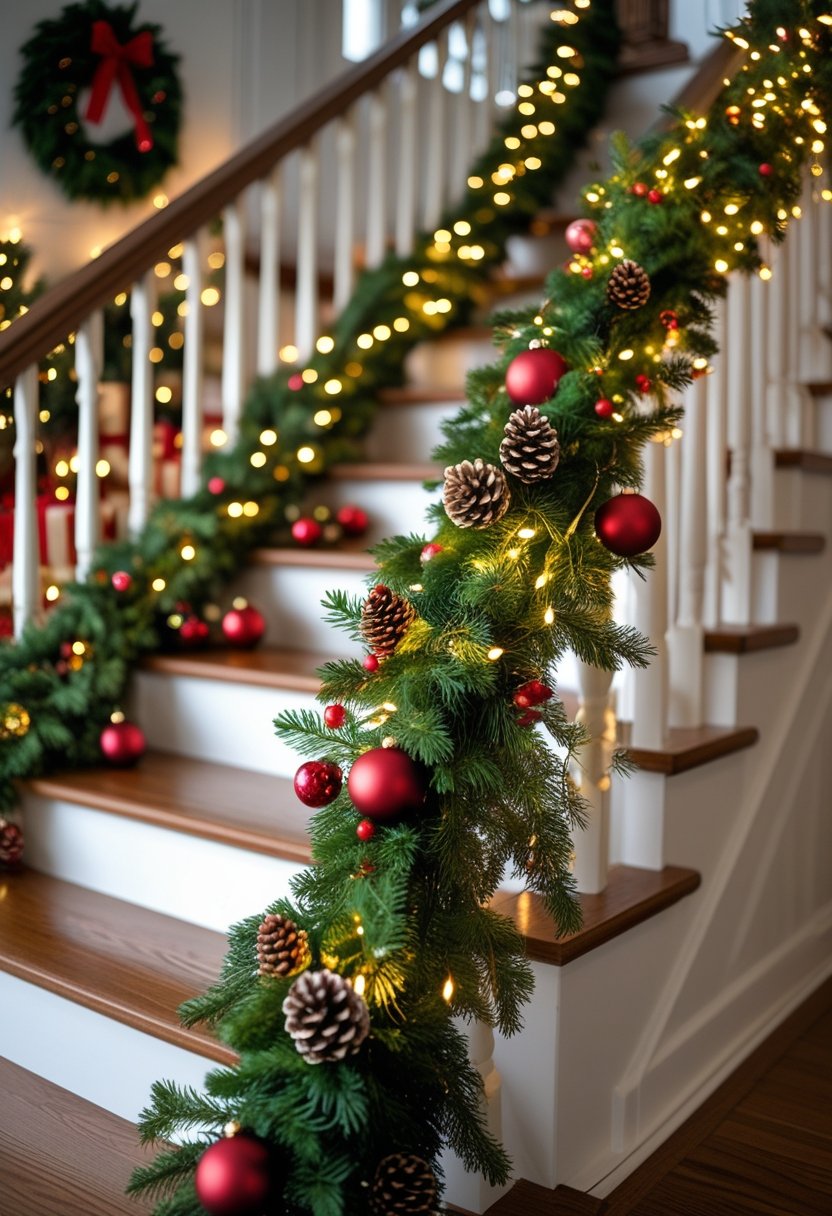
Decorating a staircase involves careful planning to ensure both beauty and safety. Proper securing methods prevent accidents, while balanced color choices and personalized touches make the decor inviting and cohesive.
Securing Decorations for Safety
It is essential to firmly attach garlands, lights, and ornaments to avoid slipping or falling. Loose decorations can create tripping hazards, especially on stairs where balance is critical.
Use strong adhesive hooks or stair railing clips designed to hold weight safely. Avoid nails or staples that could damage surfaces or become unstable.
Keep electrical cords tucked away from walking paths to prevent tripping or electrical hazards. Battery-operated string lights reduce cord clutter and improve safety.
Checking the sturdiness of each decoration periodically during the season ensures nothing becomes loose over time, maintaining a secure setup.
Using Zip Ties and Attachment Methods
Zip ties offer a reliable and efficient way to fasten garlands and lights to banisters without causing damage. They provide a snug fit that holds decorations firmly in place.
When using zip ties, trim excess length to avoid sharp edges that may snag clothing or skin. Plastic-coated cable ties protect delicate surfaces and reduce the risk of slipping.
Alternatives like floral wire or twist ties work well for lighter decorations or more flexible placement. Combining zip ties with adhesive hooks creates an added layer of stability.
Always test attachment points gently before finalizing to ensure the decoration will not shift, even if bumped or brushed.
Balancing Color and Style for Cohesive Results
To achieve a polished look, select a limited color palette that complements the surrounding space. A balance of reds, greens, metallics, or neutrals works well for traditional and modern themes.
Mix texture through various materials like velvet ribbons, pinecones, and glass ornaments to add visual interest without overwhelming the senses.
Place larger decorations at the bottom or starting points of the staircase and smaller ones higher up to guide the eye naturally along the banister.
Avoid cluttering by spacing elements evenly. This approach helps maintain an inviting flow and prevents the staircase from feeling crowded or busy.
Personalizing With Unique and Sentimental Pieces
Incorporating heirlooms or handcrafted decorations adds warmth and meaning to the display. Small picture frames, miniature stockings with names, or handmade ornaments enhance a personalized feel.
Mix these pieces with fresh greenery and classic decor to blend tradition with personal style. It also encourages guests to pause and appreciate the story behind each decoration.
Secure sentimental items carefully with soft ties or padded clips to avoid damage. Keep fragile items away from high-traffic areas to reduce the risk of accidents.
Personalization can extend to themed accents, like family initials or favorite holiday colors, creating a staircase that feels truly unique and welcoming.

Ana Luisa
Explore in-depth biographies, net worth insights, and exclusive updates on your favorite singers at Trionua.com. Discover the journeys, achievements, and latest news about music’s biggest stars.


 **A well-designed [contemporary staircase](https://trionua.com/modern-staircase-ideas/) merges sleek geometric details with inviting wood finishes to achieve both style and practicality in any home.** This combination transforms staircases from simple connectors into key architectural features that enhance a room's ambiance. By focusing on material contrasts and thoughtful design, staircases incorporate space-saving solutions and elegant lighting, making them more than just a means of moving between floors—they become a defining element of the living space. ## Core Elements of Contemporary Staircase Design  Contemporary staircases balance aesthetics with practical use, drawing attention through clean lines and thoughtful material choices. Key considerations include how the design maximizes space and light, while ensuring safety and ease of use in modern homes. ### Balancing Style and Functionality A contemporary staircase must deliver both visual appeal and secure, practical use. It often features geometric railings that act as artistic statements while providing sturdy support. The design includes precise proportions to ensure comfort in stepping, avoiding overly steep or shallow risers. Integrated lighting, such as LED strips under steps, improves safety without disrupting the clean look. Functionality extends to [storage options](https://trionua.com/elegant-under-stairs-nook/) built beneath stairs, merging utility with style. Modern staircases emphasize durability and ease of maintenance, balancing sleek design with everyday use. ### Emphasizing Open and Airy Concepts Modern staircases often incorporate open risers or transparent materials like glass panels to create a sense of spaciousness. These choices allow [natural light](https://trionua.com/terrace-goals-light-filled-luxury-spaces/) to flow through the structure, maintaining an open feel essential in contemporary interiors. Avoiding bulky components keeps the staircase visually light. This approach fits well in smaller or multi-purpose areas by maximizing perceived space. Geometric railings, often made from metal or cable, add structure without closing off sightlines, enhancing the staircase’s sculptural quality. ### Choosing the Right Materials Material selection directly influences both style and longevity. Wood is popular for its warmth and natural texture, often paired with metal or glass to introduce modern contrasts. For railings, metals such as steel or aluminum provide strength and a sleek finish. Glass panels increase transparency and modernity, while also offering safety without disrupting the design’s flow. The right combination—for example, warm wooden treads with geometric metal railings—creates balance. Materials are chosen not only for aesthetics but also for durability, ensuring the staircase suits the demands of daily use in modern homes. ## The Impact of Geometric Railings  Geometric railings offer a precise balance of style and structural function, shaping the visual language of contemporary staircases. Their patterns define the space and influence lighting, texture, and the overall spatial experience. Focused choices in design and materials ensure that these railings become both an architectural anchor and a refined aesthetic statement. ### Statement-Making Geometric Patterns Geometric railing patterns use shapes like triangles, diamonds, and interlocking polygons to create visual interest. These often rely on repetition, symmetry, and angular lines to guide the eye. Patterns such as diagonal bars or intersecting grids give staircases a bold and modern presence. When arranged thoughtfully, they can emphasize height and draw attention to a staircase’s form. These designs also provide safety without creating visual bulk. The openness of [geometric railings](https://trionua.com/modern-glass-house/) allows light to permeate the area, maintaining an airy feel. ### Materials and Finishes for Railings Metal railings are the most common choice for geometric designs due to their strength and flexibility. Steel and aluminum enable thin, clean lines that hold complex geometric shapes reliably. Popular finishes include matte black, brushed nickel, and powder-coated colors that enhance durability while complementing various interiors. Metal’s reflective qualities can contrast or harmonize with warm wooden accents on stair treads or handrails. Proper treatment prevents corrosion and maintains the railings’ sharp appearance over time. This combination of material and finish is crucial for balancing robustness with style. ### Geometric Design Integration with Architecture A geometric railing should align with the home’s architectural style for coherence. In modern or industrial spaces, metal railings with sharp, angular patterns complement minimalist or exposed materials like brick and concrete. The integration with warm wooden accents softens the metal’s starkness, creating a blend of natural and engineered elements. This contrast highlights different textures and enriches the overall aesthetic. When designed in harmony, the railing becomes part of a greater architectural narrative rather than a disconnected feature. This integration elevates both staircase function and design impact. ## Warmth and Texture: Wooden Accents in Staircase Design  Wooden accents add depth and [natural warmth](https://trionua.com/minimalist-beige-kitchen-with-marble-island/) to contemporary staircases, enhancing both aesthetics and comfort. Key factors include the type of wood used for treads, how wood pairs with other materials, and the finishing touches that define modern appeal. ### Utilizing Wooden Treads for Visual Appeal Wooden treads are a focal point in staircase design, offering tactile warmth and rich texture. They work well in various formats, such as floating staircases and wooden spiral staircases, where the wood’s grain can be fully showcased. Choosing hardwoods like oak, walnut, or maple is common due to their durability and attractive finishes. Thickness and width also affect the look: wider treads create a solid, sturdy impression, while thinner profiles complement minimalist, floating designs. Additionally, contrasting wooden treads against metal or glass risers can create sharp visual interest without compromising warmth. ### Mixing Wood with Modern Materials Combining wood with sleek materials like glass, steel, or white-painted elements balances warmth with modernity. For example, wooden treads with glass railings maintain openness and lightness while preserving natural texture. Metal supports paired with wooden steps emphasize geometry and structure, highlighting clean lines typical of contemporary design. Incorporating built-in storage beneath wooden staircases can also improve functionality without detracting from the wood's tactile quality. Floating wooden staircases exemplify this blend, where the absence of visible supports gives a minimalist feel, and the wood keeps it inviting rather than stark. ### Finishes and Stain Selection for Contemporary Looks Finish selection shapes the tone and durability of wooden staircase accents. Matte or satin finishes maintain a natural look without excessive shine, which fits contemporary styles better than glossy coatings. Light stains reveal the wood’s natural color while brightening a space, especially in smaller stair wells or dark interiors. Dark stains, such as espresso or walnut, provide contrast when paired with white risers or metal railings, enhancing the staircase’s geometric designs. Protective treatments like polyurethane increase resistance to wear without altering texture. Clear finishes that retain the wood's natural grain emphasize authenticity and craftsmanship important in modern wooden staircase designs. ## Popular Contemporary Staircase Styles  Contemporary staircases often combine [clean lines](https://trionua.com/modern-bathroom-with-marble-lighting/), [innovative shapes](https://trionua.com/entry-door-design/), and carefully chosen materials. Designers focus on maximizing space, light, and visual impact while maintaining practicality. The following styles highlight key trends and design choices in modern stair construction. ### Floating and Cantilevered Staircases Floating staircases create the illusion of steps suspended without support, offering a light and airy feel. Typically anchored on one side, cantilevered staircases extend steps directly from a wall, avoiding bulky stringers. These styles often use [warm wooden treads](https://trionua.com/modern-cozy-small-living-room-decor-ideas/) paired with glass or thin metal railings to balance softness with precision. This combination allows natural light to flow through while maintaining safety. The [minimalist look](https://trionua.com/modern-tv-wall-designs/) emphasizes [open space](https://trionua.com/outdoor-designs/) beneath the stairs, making rooms appear larger. LED strip lighting is frequently installed under each tread to improve visibility and add subtle ambiance. ### Spiral and Curved Staircases Spiral staircases optimize vertical space, ideal for smaller areas. Their cylindrical shape fits compact footprints without sacrificing style. Curved staircases provide smooth transitions between levels with graceful, flowing lines. They often serve as elegant focal points in open-plan homes. Materials vary, but combining metal railings with wooden steps is common to introduce warmth and contrast. Both styles require careful engineering for safety and structural integrity due to their unique shapes. ### Wide, Open, and Zigzag Staircases Wide staircases offer a grand appearance while improving accessibility by providing ample step width. They work well in spacious interiors. Open staircases lack risers between treads, contributing to a modern aesthetic and promoting light circulation. Zigzag staircases feature angular geometric shapes, often echoed in their railings. These designs blend style and function by making movement visually interesting and comfortable. Wood accents alongside metal or glass elements help balance warmth and modernity. ### Minimalist Metal Staircases Minimalist metal staircases emphasize simplicity and durability. They frequently feature clean, straight lines with powder-coated steel or aluminum construction. Railings are streamlined, focusing on geometric patterns such as squares, rectangles, or linear bars. These provide visual structure without overwhelming other design elements. Metal staircases pair well with wooden treads or accents, softening industrial materials with natural textures. The emphasis is on functionality and an uncluttered appearance that complements contemporary interiors. ## Maximizing Functionality in Modern Staircase Designs  Effective staircase design balances [space efficiency](https://trionua.com/the-best-country-kitchen-design/), safety, and user comfort without sacrificing aesthetic appeal. Achieving this involves clever integration of storage, thoughtful safety measures, and strategic lighting to enhance both usability and style. ### Incorporating Storage and Multi-Use Features Staircases with built-in storage optimize limited space while maintaining a clean look. Drawers or cabinets can be integrated beneath steps or within the staircase structure, offering concealed storage for shoes, books, or household items. Multi-use features like seating nooks or display shelves along stair landings add practical functionality. Incorporating a stair runner can protect finishes and reduce noise, improving the stair’s usability while complementing wooden accents and geometric railings. ### Safety Considerations Without Compromising Style Safety elements are essential in modern staircases but need not disrupt design cohesion. Non-slip stair treads and well-fitted stair runners provide traction without detracting from clean lines or material choices. Railings with striking geometric patterns can be engineered for strength and height compliance, ensuring protection without bulkiness. Clear glass panels or open risers maintain openness and visibility while meeting safety codes when combined with secure handrails. ### Lighting Techniques for Practicality and Ambiance Lighting enhances stair safety and defines ambiance through layered approaches. LED strip lights installed beneath each step illuminate the tread clearly, reducing trip hazards and adding subtle warmth to wooden surfaces. Wall-mounted fixtures or recessed spotlights can highlight handrails and railings, emphasizing geometric designs. Combining functional lighting with softer accent lights creates a balanced environment that supports daily use and visual appeal. ## Sustainable and Eco-Friendly Staircase Approaches  Staircase design today prioritizes materials and methods that reduce environmental impact without sacrificing durability or aesthetics. Wood, metal, and glass sourced responsibly can create structures that last and minimize waste. Efficiency in use of resources extends the lifespan and functionality of staircases. ### Selecting Sustainable Materials Using reclaimed wood for treads offers a low-impact alternative to newly harvested timber. This material retains warmth and natural beauty, enhancing geometric railing designs with organic texture. Bamboo is another option, known for rapid regrowth and strength, suitable for steps and accents. Recycled metals provide structure while reducing the need for virgin resources. They support modern, industrial looks and pair well with wooden elements to balance warmth and sleekness. Key considerations for selecting materials include: * Source certification (FSC, SFI) for wood * Durability to reduce replacement frequency * Low-impact processing and transport Attention to these factors helps ensure the staircase is both eco-friendly and visually striking. ### Designing for Energy Efficiency and Longevity Longevity in staircase design reduces waste and environmental toll. Using robust joinery methods and finishes enhances durability in daily use. Wood treatments that avoid toxic chemicals improve indoor air quality and maintain sustainable standards. Energy efficiency can extend beyond the structure itself. Incorporating natural or LED lighting integrated into the design reduces energy consumption. Thoughtful placement of open risers or glass panels allows light flow, creating a brighter and more inviting space without extra power use. Maintenance-friendly surfaces and modular elements streamline repairs and updates, encouraging longer use rather than full replacement.](https://trionua.com/wp-content/uploads/2025/07/v2-ykrja-aydrq-768x1122.jpg)

